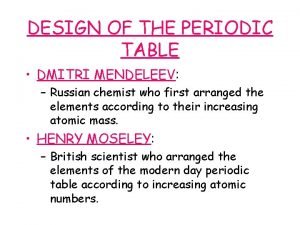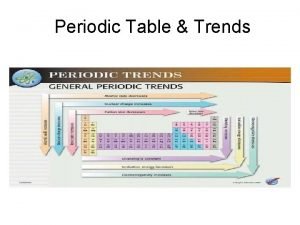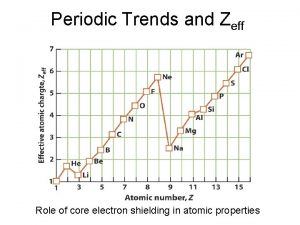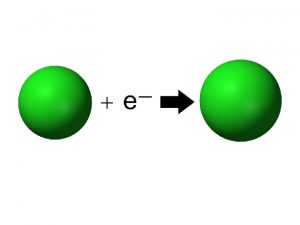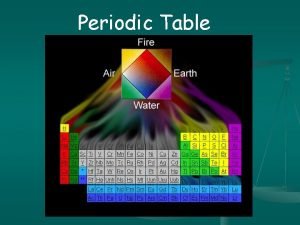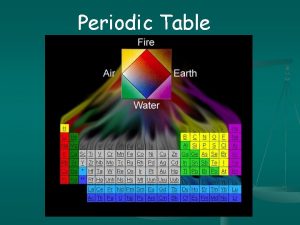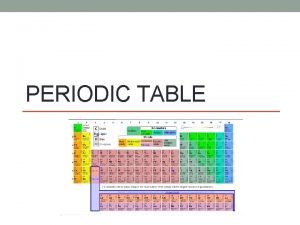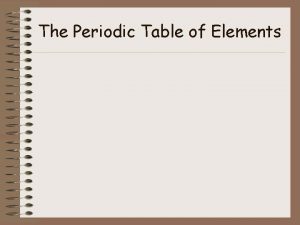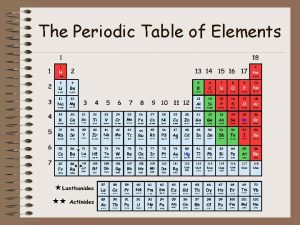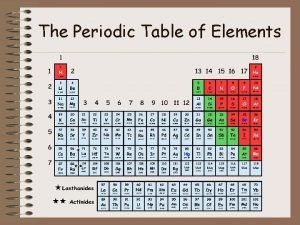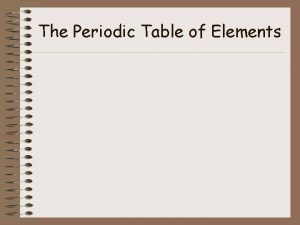Notes on Periodic Trends The elements are arranged
























- Slides: 24

Notes on… Periodic Trends The elements are arranged on the periodic table in a very specific and awesome way… Certain characteristics of atoms show trends within the groups (columns) and periods (rows). These trends are observed as a gradual increase or decrease in the value of these characteristics.

Periodic Trends The trending of these characteristics is dependent on two properties of atoms: 1. The highest energy level that contains electrons = each period adds another energy level around the nucleus What is an energy level? 2. The number of protons and electrons in the atom = the more protons and electrons in the atom, the stronger the attractive force

Periodic Trends There are 3 characteristics of atoms that we will study trends for: 1. Atom Radius (size) 2. Ionization Energy 3. Electronegativity

Trend #1 – Atomic Radius

Trend #1 – Atomic Radius Going Down a Group Why do atoms get bigger going down a group?

Trend #1 – Atomic Radius Going Down a Group Why do atoms get bigger going down a group? Each period down adds another energy level around the nucleus, increasing the size of the atom

Trend #1 – Atomic Radius Going Down a Group Why do atoms get bigger going down a group? Each period down adds another energy level around the nucleus, increasing the size of the atom Going Across a Period Why do atoms get smaller going left to right across a period?

Trend #1 – Atomic Radius Going Down a Group Why do atoms get bigger going down a group? Each period down adds another energy level around the nucleus, increasing the size of the atom Going Across a Period Why do atoms get smaller going left to right across a period? The number of protons increases moving across a period, increasing the attraction between the nucleus and the electrons. This attraction shrinks the atom.

Trend #1 – Atomic Radius *arrow points in direction of increase*

Trend #2 – Ionization Energy

Trend #2 – Ionization Energy The higher the ionization energy for an atom, the harder it is to remove an electron from the atom. The lower the ionization energy for an atom, the easier it is to remove an electron from that atom.

Trend #2 – Ionization Energy Going Down a Group Why is it easier to remove electrons from atoms further down a group?

Trend #2 – Ionization Energy Going Down a Group Why is it easier to remove electrons from atoms further down a group? The atoms are larger and electrons are farther from the nucleus. This makes the electrons easier to remove.

Trend #2 – Ionization Energy Going Down a Group Why is it easier to remove electrons from atoms further down a group? The atoms are larger and electrons are farther from the nucleus. This makes the electrons easier to remove. Going Across a Period Why is it harder to remove electrons as you move left to right across a period?

Trend #2 – Ionization Energy Going Down a Group Why is it easier to remove electrons from atoms further down a group? The atoms are larger and electrons are farther from the nucleus. This makes the electrons easier to remove. Going Across a Period Why is it harder to remove electrons as you move left to right across a period? The atoms are smaller moving right across the periodic table with electrons closer to the nucleus. This makes the electrons harder to remove.

Trend #2 – Ionization Energy *arrow points in direction of increase*

Trend #3 – Electronegativity An atoms ability to attract electrons

Trend #3 – Electronegativity Going Down a Group What is the trend for electronegativity going down a group?

Trend #3 – Electronegativity Going Down a Group What is the trend for electronegativity going down a group? Electronegativity decreases moving down a group

Trend #3 – Electronegativity Going Across a Period What is the trend for electronegativity going right across a period?

Trend #3 – Electronegativity Going Across a Period What is the trend for electronegativity going right across a period? Electronegativity increases moving right to left across a period.

Trend #3 – Electronegativity *arrow points in direction of increase*

Let’s use what we’ve learned Take out your Periodic Table. Answer the following questions: 1. Which element has the largest atomic size? Li Na Be 2. Which element has the lowest ionization energy? S Se Cl 3. Which element has the highest electronegativity? C N Si

Let’s use what we’ve learned Take out your Periodic Table. Answer the following questions: 1. Which element has the largest atomic size? Li Na Be 2. Which element has the lowest ionization energy? S Se Cl 3. Which element has the highest electronegativity? C N Si
 Mikael ferm
Mikael ferm Trends periodic table
Trends periodic table 15/999 mass street periodic table, o 8
15/999 mass street periodic table, o 8 Periodic trends in properties of elements
Periodic trends in properties of elements Who arranged the periodic table
Who arranged the periodic table How did mendeleev arrange the elements? *
How did mendeleev arrange the elements? * Trend for ionic radius
Trend for ionic radius Periodic trends
Periodic trends Valence electron cheat sheet
Valence electron cheat sheet Ap chemistry chapter 7 atomic structure and periodicity
Ap chemistry chapter 7 atomic structure and periodicity Graphing periodic trends
Graphing periodic trends Oxidation trends periodic table
Oxidation trends periodic table Periodic trends electronegativity
Periodic trends electronegativity Zeff periodic table trend
Zeff periodic table trend Periodic trends activity worksheet
Periodic trends activity worksheet Periodic trends practice questions
Periodic trends practice questions Periodic trends in reactivity
Periodic trends in reactivity Periodic trends summary
Periodic trends summary Electron configuration practice problems
Electron configuration practice problems Coulomb's law electronegativity
Coulomb's law electronegativity Periodic trends electron affinity
Periodic trends electron affinity Increasing atomic size
Increasing atomic size Atomic radii periodic table
Atomic radii periodic table Atomic radius definition
Atomic radius definition Periodic trends acidity
Periodic trends acidity




